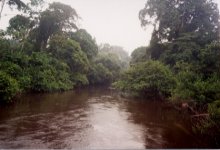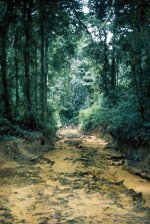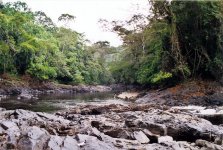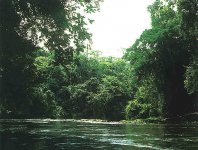After being two weeks in Liberia where I worked at a refuge camp together with the UN, I came back home to Cameroon again,
The rain season has now come to the Cameroon highlands and the only way to travel on my old, lovely patch is either to swim with is a bit risky, and the other way is to go up stream with boat, a few high elevated areas upstream usually stay rather dry, even during the rain season and usually don’t tend to get flooded, those few places is the main places for all the rainforest mammal to find food during the wet season as the rest of covered with water, the grasslands around Mbuko observation tower is such a place and among the most reliably sites, I have visited this place during the rain season the past two years and it have been the only place of the patch which has been suitable for bird watching, hundreds of bird come together at the grasslands below Mbuko observation tower during this time of the year, you see about 4 times as much bird this of the year than you do the rest of the year, the birds gather in larger groups and in a smaller area, grassland birds such weavers, sunbirds, sparrows and starlings can only bee seen in areas such this during the rain season.
I visited the Mbuko observation tower three hours last Friday; I hadn’t planed to bird this day but I meet some French people earlier during the day in my home village they was on a missionary trip in West Africa and planed to settle down in Cameroon, they had told a friend of mine that they wanted to go “birding in the jungle”, but as he cant even id a sparrow he recommended they to search u me if they wanted to go for some birding later that day. We headed out in the early afternoon but it took some 2 hours to reach Mbuko observation tower because you have to travel up stream and on the way make sure you don’t get hit by to many large tree trunks or get stuck on some large rocks, this time of the year millions of insects start to fly every where, especially around rivers and we got some hundreds or so in the eyes, ears, in the hair, yes everywhere, we felt quite a relief, or at least the French couple, when we finally reached the grasslands surrounding Mbuko observation tower. To my surprise it was quite “crowded” this day and we meet no less than 7 tourists on our way up to the tower, the first birds we spotted was a flock of Cameroon and Green-throated sunbirds which was feeding on some flowers in a few small bushes, the French couple first thought it was a couple of hummingbirds as the thought the bill was very familiar to the ones of hummingbirds, but I told them that we don’t have any hummingbirds in Africa. The couple got terrified by the next bird which showed up, a Senegal coucal which took of from the long grass surrounding the narrow patch and perched itself in a tree they had apparently thought that the bird was trying to attack them, I started to think to myself how this day would end, as we had planned to spend some three hours at the tower and they got terrified as soon as they saw a bird larger than a sparrow. But we didn’t seen any more birds on the way to the tower and that made me “happy”, it was also quite crowded up in the tower and a huge tourist large group of 30 Germans was there to watch butterflies and goliath bugs and to add to that there was probably another 10-12 people in the tower, I have never seen such a number of people in this tower before, and this time of the year? I got really confused by that. However we still found a very good spot in the crowd, the first thing I noted was a red-collared widowbird and flocks of Grey parrots as usually was present, but this time the number was about three times as large as it use to be, the flocks easily numbered several thousand birds, once again the French couple got surprised, they had apparently owned a Grey parrot a few years ago but they never believed that this bird was found in the wild, in the small mineral rich lakes, large number of ducks had gathered to feed on seeds, insects and maybe just take a swim, ducks usually tends to stay away from this habitat during the wet season as there is plenty of “newly” created lakes and rivers all over the forest, but Egyptian goose (my first ones in Cameroon for the year), African pygmy duck, African black duck and Hartlaubs duck were all present, although in various number, many Egyptians and black ducks but few African pygmy ducks, white-headed lapwing, Forbes plover, Purple heron and Black-crowned Night-heron was other water birds present. Far away, almost on the opposite side of the tower a small group of Woolly-necked storks was feeding in the muddy ditches or just took some time to clean themselves, I also recognized a dull grey bird in the flock with woolly-necks; I assume it was a juvenile Yellow-billed stork. Hadada ibis was heard several times from the forest, right behind the tower, but we never got a glimp of it, I spoke to a British guy who had been at the tower since very early in the morning, he had apparently seen both spot-breasted Ibis and Ayres hawk-eagle in the early hours of the morning. Got very jealous on that, but we sure would get our amount of raptors that day (something that I didn’t knew by then). A Chocolate-backed kingfisher took some short trips out of the forest and scoped over the small lakes to find out if they hold any nice fish, while both shining-blue kingfisher and woodland kingfisher were present almost the whole time, both making some failed attempts to catch fish. Bronze manikin, Northern Grey-headed sparrow and Pied crow (a few birds are resident here) where all inhabiting the tower itself, the French couple didn’t dared to approach any of the small birds in fear of getting bird flue, despite I said it was unlikely that any of the birds here, deep in the rainforest had been affected. We got a few fast glimpse of the beautiful Fiery-breasted bush-shrike as an adult male was feeding in a tree just at the forest edge together with a few black-winged orioles. The first bird which really caught the interest of the French was groups of Purple-headed glossy starlings which had come out of the forest to feed on insects, the small birds jumped around at the base of the tower and really shined like jewels as the sun hit them, a bare-cheeked trogon wasn’t bad either but seen at far distance. Weavers are among my favourites and they are nesting all around the grassland in Mbuko, as many as 13 different species of weaver was recorded in and around Mbuko by a Dutch guy in 2003. I have never seen more than 8 species here but today I got my first sighting of a species I have only seen a couple of times before, the Black-billed weaver, ohhhh what a beauty it is, in a large colony of village weavers I noted a few nests which didn’t look quite like the ones of the village, I watched the colony for a long time, I didn’t get much exept a few female village weavers which repaired their nests, but then suddenly, there it was, two males black-billed weavers sitting in a high tree some 100m away from the tower, the bird got everyone’s attention and they also seemed to enjoy it as they sat on the branch for a long time before they vanished in the leaflet, in hunt for food probably. Later the day I also manage to get compact weaver which seems curiously scarce this year (the two following years I have counted them in dozens in Mbuko), Black-necked weaver, the second most abundant here, Maxwell black weaver quite common, Yellow-mantled weaver and Golden-backed weaver which both was scarce as they normally inhabits more low-elevated habitat but visits the highlands during wet-season and also breeds in some numbers. Weavers are easily located just at the forest edge and 4 of the weavers nested just around the tower so you could get some excellent views of them, black dwarf hornbill was an unusual visitor and you can’t expect to find it here, Black-winged bishop and Fraser’s and Olive sunbird was shortly noted. We then took a short lunch together with the Germans which told us how they had travelled around half Africa the past 7 months and that they worked for some university in Kenya, they told us lot of interesting stories originating from all of Africa, and some stories were really amazing. Then suddenly a guy shouted that some kind of raptor had entered the grassland, it took some time to locate it as it flew back and forth over the forest and sometimes flew out of our eye site, but I got at least a few glimpse of the bird and from what I could figured out it must have been a Congo serpent-eagle, the way if flew also reminds me of the serpent-eagle, this is not a very rare species but surely among the birds of the West African rainforest which is most hard to locate, they hide in the forest canopy during most of them day, often very high up and a few times each day it flies around in search for a prey and also then high above the forest canopy and rarely enters open habitat as its main prey small monkies and tree hyraxes which both stays in the canopy, this is just the third time I see this species and my first time I see it in Cameroon. We had seen a lot of duikers, red river hog and sitatunga antelopes most of the day and they aren’t very hard to see as they tends to stay around this kind of habitat all year around, but the really surprise came when a heard of six elephants run out of the forest, it what seemed to be three young ones and three adult females, they then took a short walk on the other side of the grassland, they were probably aware of us and kept a very large distance all the time, they just had a short walk in the open before they vanished inside the cover of the forest again, this is the first time I see elephants in West Africa and they surely are extremely rare now, Cameroon might hold as few as 150 of these forest elephants today, and most of them occur in this western part, but if they are extremely rare, they are even more shy, I spoke to a local down in the village when we come back and he told me that no elephants had been sighted anywhere near Mbuko the last 5 years. So an important record for sure, but they were gone in just a minute and we started to watch the birds again, which at least were quite resident. The first swifts of the day was seen in the mid afternoon when the sun became less intensive, and the wind increased, mixed flocks with Mottled spinetail and a few Bates swifts was for some time flying over the grassland feeding on insects, the only egret which was seen during the day was a single Great egret which had company with two hamerkops, the hamerkops acutely came as a surprise as I have only rarely seen them here before, but they visits these highland grasslands during the rain season has they harbour 4 times as much food as the lowlands during this period of the year. A Olive long-tailed cuckoo was heard from inside the forest and its special sound was easy to note, some Grey-headed negrofinches, by the time a few red-fronted parrots has joined the Grey ones, African emerald cuckoo, Yellowbill, African green pigeon, Blue-headed wood dove and Bronze-naped dove where all numerous around the tower where they was feeding on fruits, berries and insects together with weavers, Crested Guinea fowl was also starting to move out of the forests as the temperature got colder, but they mainly stuck to the forest edge, so did a nervous black crake. The incredible beautiful white-crested hornbill had by the time slowly start to move out of the forest, another forest bird which you mostly cant expect to see here, hairy-breasted barbet, a buff-spotted woodpecker was the first and only woodpecker noted, it climbed at an old trunk just above the roof of the tower and we didn’t see it before it made some sounds. A common bulbul was at the other hand seen sitting just a few inches from me and also that one was the first bulbul of the day. Buff-throated apalis, short-winged ciscitcola, Dusky flycatcher, Chestnut wattle-eye and African thrush was some of the smaller birds which was being found in the forest edge, a few forest white-eyes and Johanna sunbirds was brave enough to enter more open habitat to feed. The French started to get tired and we planned to start heading back to the village, a last glimpse of Long-crested eagle and a Red-billed Helmet-shrike seen flying rapidly above us on the way to the boat made the day complete
 , I have made an estimate, about 45% of the natural forest remains in this locality. Luckliy the hunting preasure seems to be almost none exstintence here.
, I have made an estimate, about 45% of the natural forest remains in this locality. Luckliy the hunting preasure seems to be almost none exstintence here.







![DSCF0348[1].jpg](/data/attachments/36/36377-d7853e7dd473a88b5fa366e48e539534.jpg)
![forest[2].jpg](/data/attachments/36/36381-622598aed6c7f3588ec91ac602bea721.jpg)
![01081672[1].jpg](/data/attachments/49/49259-9758eac921c36ecf5c121f041ad7bad2.jpg)
![01126956[1].jpg](/data/attachments/49/49260-31f369e4ff439a988519877395d7e5bc.jpg)
![01126959[1].jpg](/data/attachments/49/49264-cc09accc445290dad90853ed5c162268.jpg)